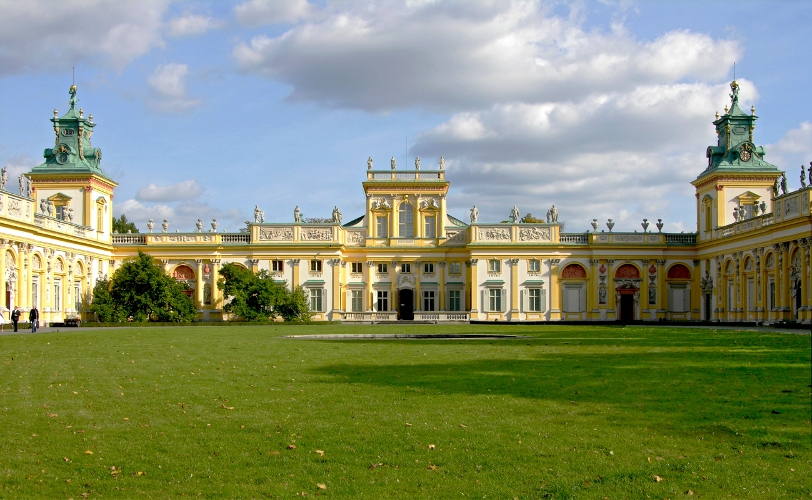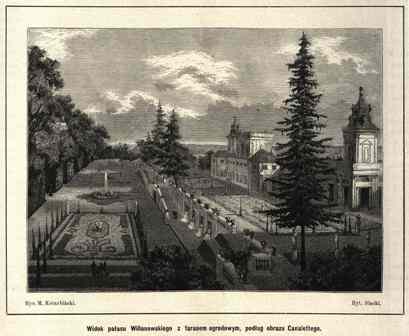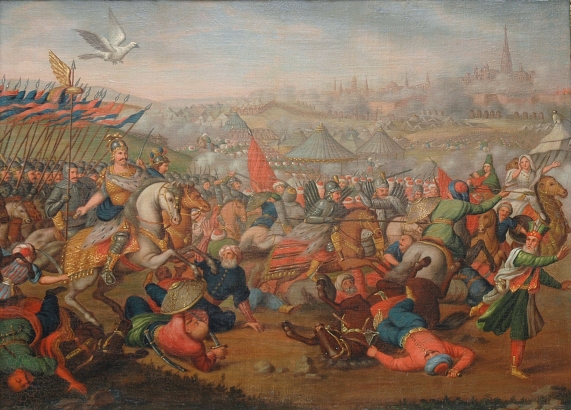‘Aulicus intimus et secretarius noster’, or, Faithful Servant and Artistic Aide to King Jan III, Agostino Vincenzo Locci
‘Aulicus intimus et secretarius noster’, or, Faithful Servant and Artistic Aide to King Jan III, Agostino Vincenzo Locci - Photo gallery
Agostino Vincenzo Locci ‘the Younger’ of the Lew (Lion) coat of arms (1640–1732) was a Warsaw-born son of the Italian royal architect and decorator Agostino Locci ‘the Elder’, an employee of the Vasas, and a Warsaw bourgeois, Urszula Dorota née Giza. The young Agostino’s first lessons in architecture and plastic arts were most likely given by his father, and then probably by Giovanni Battista Gisleni (1600–72), a Roman architect active in Poland and a friend of the family. The artistic education of Agostino Vincenzo Locci, rooted in Polish circumstances, was supplemented by Italian educators with a trip to Rome around 1680 and frequent professional encounters with leading architects, sculptors, and artists operating in the Commonwealth.
Locci’s association — which developed into a long-term tie — with King Jan III Sobieski began when the artist found employment in the construction of the palace at Wilanów in 1677–94. The letters Locci wrote to the King in the years when the palace was being raised, when the monarch left his beloved residence on important duties, are an incomparable source on the Italian’s activities under Jan III’s patronage. Concurrently — since the 1670s — Locci also took part in decorating the castle of the Princes Radziwiłł at Zhovkva and in construction and decorative works at the Royal Castle in Warsaw. Another of Jan III’s construction initiatives — the Capuchin church and monastery at Miodowa Street in Warsaw — saw the architect take up a crucial leadership role. Around 1692 Locci also completed designs for paintings and decorations of the cupola, tambour, and the presbytery wall at the church of Saint Casimir at Nowy Świat Street in Warsaw, designed by Tielman van Gameren and built for the Benedictine Sisters of the Perpetual Adoration of the Blessed Sacrament, known as Sacramentines, brought to Poland in 1687 by Queen Marie Casimire. Locci also worked for other magnates, including the Radziwiłłs (castles at Zhovkva and Biała Podlaska), the Royal Secretary Stanisław Antoni Szczuka (palace at Radzyń Podlaski and a manor house in Winiary upon the Pilica river), and — already in the following century — Hetman Adam Sieniawski (Sieniawski Palace at 5 Krakowskie Przedmieście Street in Warsaw). During the reign of August II, the architect may have been employed in the construction of the Saxon Palace in Warsaw.
Several of Agostino Vincenzo Locci’s aforementioned undertakings are worthy of a deeper consideration. Locci was employed in the building of the palace at Wilanów in 1677–94. The first stage of his activities, dated at 1677–83, is best characterised by the text of a royal receipt for a portion of the works, held in the Royal Register and published by the indomitable explorer of the history of the Wilanów residence, Juliusz Starzyński: ‘… We inform those entitled to know that the Receipt, Precept, and expenses for the Villanova Factory submitted since diebus Mai One Thousand Six Hundred Eighty Three by Our Secretary, born Augustin Locci, Our Commissioners are instructed to accept; as within these Receipts he has completely satisfied Us, therefore We Certify them with Our Script. Furthermore, for additional credence, we sign them in our own hand. Given at Wilanów die Decima Octava Iuli Millesimo, Sexcentesimo, Octuagesimo Tertio. The Tenth Year of Our Rule. Jan the King’ (quot. from: J. Starzyński, Wilanów. Dzieje budowy pałacu, p. 16). More details on the building of the palace and the involvement of our architect can be found in the aforementioned letters from Locci to Jan III, known thanks to the publications of J. Starzyński. This correspondence is very interesting — while the topics addressed can often seem surprising, the engineer-architect’s voice is always sober and filled with humility in the face of the King. Locci consulted most alterations with Jan III, observed the proper conduct of the construction works, acted as guide for guests during the King’s absence, paid the artisans, stonemasons, sculptors and carvers, among others (whom he also hired), oversaw their progress, and terminated employment, if necessary. Locci’s activity was not limited solely to supervising the so-called Wilanów factory — he was also an active counsellor and ardent critic of the implemented solutions (e.g. the garden sculpture portraying the goddess Diana); the author of architectonic drawings (e.g. the galleries of the palace, towers — known as vaults — the final shape of the two-storied main body, rooftops, windows, doorways, balustrades) and numerous construction solutions (in the palace as well as the garden), as well as select iconographic programmes for the decoration of architectural components and the palace interiors; and also the designer of garden buildings, living quarters, and farm buildings (e.g. the tavern) at Wilanów.
Apparently satisfied with Locci’s performance, King Jan III also tasked him with preparation of the main design and construction efforts taking place in 1677–85 at the Royal Castle in Warsaw. Locci designed a pavilion situated on the Vistula side, with the so-called King’s Bath, built 1680–1. His designs were also implemented, for example, in the rebuilding and arrangement of the Main Vestibule and the Guards’ Gallery (which were divided into cabinets), the theatre hall, the New Deputies’ Chamber (with benches set according to an innovative amphitheatrical arrangement), and in the arrangement of cells for Sacramentines, brought to Poland from France by the Queen. Locci would also have had a significant impact on the creation of new decorations in the Senators’ Chamber and in the chapel at the City (Great) Tower.
Locci also played a part in erecting other buildings in Warsaw under the King’s patronage, including sacred buildings such as the Capuchin monastery on Miodowa Street (1681–6), where he had likely introduced alterations to the original design, and the Sacramentine church on Nowy Świat Street (ca. 1692), for which he designed decorations inside the dome, in the tambour, and on the presbytery walls, completed after 1693. His design was also employed in another temple inside the capital, though unrelated to Jan III’s patronage, namely the Carmelite church in Warsaw’s Leszno district (1683).
Even before the commencement of Locci’s cooperation with King Jan III, the Italian was accepted into the Polish nobility (receiving an indygenat) by King Michał Korybut Wiśniowiecki, while King Sobieski extended the privilege to Agostino’s three brothers — Francesco, Casimir, and Giovanni — in 1676. In 1675, Locci received a generous reward from Jan III, who dignified the Italian with the title of ‘aulicus intimus et secretarius noster’, along with a life-long pension of 2,000 Polish Złotys. After Jan III’s demise, thanks to a broad network of contacts and the favour of patrons, Locci came into possession of estates received from, among others, Karol Radziwiłł (in Rakowiec, Witkowiec, and Wyględów), and Stanisław Antoni Szczuka (in Grotów and Grotówek). Outside of his artistic activities, Locci also served administrative functions, for instance as the Podczaszy (Deputy Cup-Bearer) of Nowogród and Trembowla, as well as the Stolnik (Pantler) of Wyszogród.
Locci’s private life seems to have been rather uneventful. It is known that he married the daughter of the Treasurer of Sochaczew, Anna Szymanowska, in 1706. The pair had no children and left all their possessions to Locci’s nephew, Francesco. The architect lived a long life and died on 22 October 1732. He is buried in the Carmelite church in Warsaw, which he himself had designed.
In spite of his extensive activities as architect and decorator, Locci did not consider himself a professional architect, but rather an ‘engineer-technician’, which he insisted on in the aforementioned letters to the King. It is not known whether this attitude resulted from an innate humility or a political gesture consistently aimed at the monarch as his patron. One might surmise, however, that Locci was aware of the gaps in his education (he was, in fact, an amateur architect) and the strength of the competition (e.g. Tielman van Gameren), and thus opted for a reserved attitude toward his own achievements, regardless of the extreme diligence, talents for design, and, as one would call it today, management, which Locci supplemented with a constructional ingenuity and a gift for assessing the tastes and demands of his clients—virtues King Sobieski valued very highly.
A.V. Locci’s most significant projects in the Commonwealth:
- 1677–94: the Wilanów Palace (director of works: designs for galleries, façades, vaults, also living quarters, farm buildings and garden structures, garden arrangement, hydraulics and waterworks)
- 1678–9: castle at Zhovkva (decorations, Radziwiłł gallery)
- 1680–1: Royal Castle in Warsaw (rebuilding of the Main Vestibule, Guards’ Gallery, Theatre Hall, among others; new decorations in parliamentary rooms — New Deputies’ Chamber, Senators’ Chamber — quarters for the Warsaw Sacramentines, design for the pavillion with the so-called King’s Bath)
- 1681–6: Capuchin church and monastery in Warsaw (design and construction works)
- 1683: Carmelite church in Warsaw’s Leszno district (design)
- 1686: palace in Radzyń Podlaski (for Stanisław Antoni Szczuka; rebuilding of the castle and erection of the annex)
- 1689: manor house at Winiary upon Pilica (for Stanisław Antoni Szczuka; design and construction)
- ca. 1692: Sacramentine church in Warsaw (designs for decorations in the copula, tambour, and on the presbytery wall)
- ca. 1694: wooden church at Wilanów (rebuilding)
- 1717–22: palace for Adam Sieniawski (so-called Czapski Palace at 5 Krakowskie Przedmieście Street in Warsaw; design and construction)
Realisations within the Commonwealth attributed to A.V. Locci, but unconfirmed:
- entrance gate at the Radziwiłł castle in Biała Podlaska
- designs for gravestones of Jan III Sobieski’s father and uncle — Jakub Sobieski (d. 1646) and Stanisław Daniłłowicz (d. 1636) at the parish church of Saint Lawrence in Zhovkva, sculpted by Andreas Schlüter in 1692–3
Most important sources:
Piotr Bohdziewicz, Korespondencja artystyczna Elżbiety Sieniawskiej z lat 1700–1729, Warszawa 1964.
Katalog Zabytków Sztuki w Polsce, miasto Warszawa, cz. 1: Stare Miasto, ed. J. Z. Łoziński and A. Rottermund, Warszawa 1993.
Katalog Zabytków Sztuki w Polsce, miasto Warszawa, cz. 2: Nowe Miasto, ed. M. Kałamajska-Saeed, Warszawa 2001.
Stanisław Łoza, Architekci i budowniczowie w Polsce, Warszawa 1954, p. 177.
Wojciech Fijałkowski, “Augustyn Wincenty Locci,” in: Polski Słownik Biograficzny, vol. 17, Wrocław-Warszawa-Kraków-Gdańsk 1972, pp. 508–510.
Juliusz Starzyński, “Augustyn Locci, inżynier i artystyczny doradca Jana III,” Biuletyn Historii Sztuki i Kultury 1 (1932–3), pp. 119–127.
Juliusz Starzyński, Wilanów. Dzieje budowy pałacu za Jana III, Warszawa 1976.
Translation: Antoni Górny



